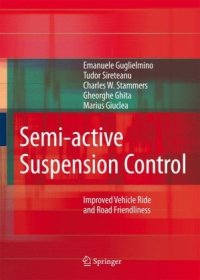
Ebook: Semi-active Suspension Control: Improved Vehicle Ride and Road Friendliness
Author: Emanuele Guglielmino Tudor Sireteanu Charles W. Stammers Ghita Gheorghe Marius Giuclea (auth.)
- Tags: Automotive and Aerospace Engineering Traffic, Vibration Dynamical Systems Control, Control Engineering, Engineering Fluid Dynamics, Biomedical Engineering
- Year: 2008
- Publisher: Springer-Verlag London
- Edition: 1
- Language: English
- pdf
Semi-active Suspension Control provides an overview of vehicle ride control employing smart semi-active damping systems (controlled dissipative elements which only require low energy input). These systems are able to tune the amount of damping in response to measured vehicle-ride and handling indicators.
Two physically different dampers (magnetorheological and controlled-friction) are analysed from the perspectives of mechatronics and control. Ride comfort, road holding, road damage and human-body modelling (nonlinear visceral response in particular) are studied.
A multidisciplinary approach is adopted throughout the book. Sound mathematical modelling is balanced by a large and detailed section on experimental implementation, where a variety of automotive applications are described offering a well-rounded view of the application of such systems. The implementation of control algorithms with regard to real-life engineering constraints is emphasised.
The applications described include semi-active suspensions for a saloon car, seat suspensions for vehicles not equipped with a primary suspension, and control of heavy-vehicle dynamic-tyre loads to reduce road damage and improve handling.
Engineers and practitioners working in noise and vibration; automotive engineers working in vehicle design, research and development; biomechanical engineers, physicists and life-scientists interested in human-body responses to vibration; and graduate students in vehicle studies, mechanics of vibration, dynamics and control will find this book of material assistance in their work.
emi-active Suspension Control provides an overview of vehicle ride control employing smart semi-active damping systems (controlled dissipative elements which only require low energy input). These systems are able to tune the amount of damping in response to measured vehicle-ride and handling indicators.Two physically different dampers (magnetorheological and controlled-friction) are analysed from the perspectives of mechatronics and control. Ride comfort, road holding, road damage and human-body modelling (nonlinear visceral response in particular) are studied.A multidisciplinary approach is adopted throughout the book. Sound mathematical modelling is balanced by a large and detailed section on experimental implementation, where a variety of automotive applications are described offering a well-rounded view of the application of such systems. The implementation of control algorithms with regard to real-life engineering constraints is emphasised.The applications described include semi-active suspensions for a saloon car, seat suspensions for vehicles not equipped with a primary suspension, and control of heavy-vehicle dynamic-tyre loads to reduce road damage and improve handling.Engineers and practitioners working in noise and vibration; automotive engineers working in vehicle design, research and development; biomechanical engineers, physicists and life-scientists interested in human-body responses to vibration; and graduate students in vehicle studies, mechanics of vibration, dynamics and control will find this book of material assistance in their work.